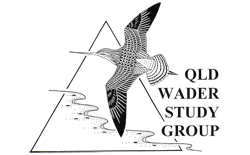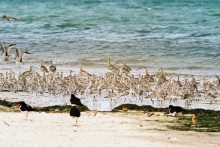Migratory shorebirds or waders spend their six or so months in Australia building up their bodies for the autumn trip to northern Asia to breed in the tundra areas. Many thousands of birds summer along the Queensland coast. They feed on mudflats around our salt-water bays and estuaries. They can only feed when the tide is low and the banks are exposed. They feed both day and night at low tide.
At high tide, they gather in large numbers at specific sites to wait out the tide, and to rest on banks or the shore above the tide level. These places are known as “high tide roosts”, and a few are signposted. These roosts are sometimes in remote spots but more often very close to human activity.
Waders usually lose up to half their body weight during their migration so they have a lot of building up to do. This involves eating, resting and not using excess energy. To achieve this, it is essential that the birds be permitted to feed and roost without disturbance. Much feeding is done on banks well off shore which are less attractive to people, but some feeding is done on foreshores.
People going for a walk, dogs running free, boat and jet-skis going by and fisherman intruding on the area, all of these disturb shorebirds both at their high tide roosts and while they are resting. As an individual please avoid putting these birds to flight, with a little care the birds and you can share the foreshore. It’s also worth remembering that in many areas heavy penalties can apply for disturbing waders and for having dogs off leash on the foreshore.
These birds face similar disturbance threats on migration and worse, many of the areas they use to recuperate and replace lost body fat are under threat of drainage which is a major threat to the well being of many shorebird species and makes the protection of these birds a truly international problem. QWSG’s projects are based around monitoring trends in the shorebirds on Moreton Bay and more widely in Queensland, using regular counting and banding and allowing that data to be used to lobby for the well being of waders both locally, nationally and internationally. This is done by working closely with local and state government and also working with our counterpart groups in other states as well as the Australasian Wader Study Group.
In addition to taking care not to disturb the waders using the foreshore here in Queensland why not join QWSG and get involved in our monitoring work and make an active contribution to ensuring we continue to see these remarkable birds returning to Queensland and to Australia in general.

